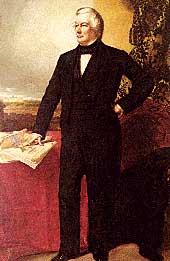Millard Fillmore, the thirteenth President of the United States (1850-53), was born into a poor farming family in New Cayuga County, New York on January 7, 1800.

Millard spent his youth helping out on the family farm and working in the shop of a clothier, attending school only sporadically. He was mostly self-taught. At the age of nineteen he began to study the law with a local judge, while supporting himself teaching school. His political career began in his mid-twenties when he became active in the Anti-Masonic Party. He was admitted to the bar in 1823 and opened a law practice outside of Buffalo. In 1826 he married Abigail Powers.

 In 1828 Millard Fillmore was elected to represent his district in the New York State Assembly. By 1833 he was elected to the United States Congress, where, as Chairman of the Ways and Means Committee, he was largely responsible for the passage of the Tariff of 1842. He ran for Governor of New York in 1844 and lost. He first came to national attention in 1848 when he was chosen by the Whig Party to be Zachary Taylor's running mate. In 1828 Millard Fillmore was elected to represent his district in the New York State Assembly. By 1833 he was elected to the United States Congress, where, as Chairman of the Ways and Means Committee, he was largely responsible for the passage of the Tariff of 1842. He ran for Governor of New York in 1844 and lost. He first came to national attention in 1848 when he was chosen by the Whig Party to be Zachary Taylor's running mate.
A conservative dresser, Fillmore always wore a dark coat and a high-collared shirt with a black silk neck cloth, which he tied into a bow. He was known for his courteous manner and his graciousness. He was such an extremely modest man that when Oxford University offered him an honorary degree, he refused to accept it because he felt he had done nothing to deserve it.

When Zachary Taylor unexpectedly died in office on July 9, 1850, Millard Fillmore became the second Vice President in US history to inherit the presidency. He came into office at a crucial point in the slavery debate. In 1850 the Compromise issue over whether California and Texas would be admitted to the Union as free or slave-holding states was being debated, and the country stood on the threshold of a Civil War.
Millard Fillmore was the last Whig President this country ever had. He became President during a critical time when the conflict between the Northern and Southern states on the issue of slavery was intensifying. By approving the Compromise of 1850, Fillmore delayed the Civil War for over ten years. This bill contained five laws, the most important of which allowed runaway slaves to be returned to their owners. Although this postponed the outbreak of war, the Compromise did little to actually appease either side. The North was particularly upset about the provision for returning slaves to their Southern masters. Fillmore lost the support of most Northerners when he enforced the Compromise of 1850.
One of the triumphs of the Fillmore presidency was the opening of a trade relationship with the Japanese. Fillmore sent the US Fleet under the command of Commodore Matthew Perry to Japan, a journey that ended the United States' policy of isolationism. When the election of 1852 came around, Millard Fillmore attended the convention, but withdrew his name from the running at a critical point, throwing his votes to Daniel Webster.

In 1856, Fillmore did run for President again as the American Party's nominee, winning only the State of Maryland. He returned to Buffalo where, in 1858, he remarried. He died in 1874.
|

